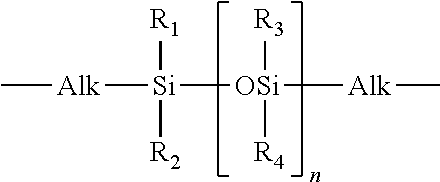Antimicrobial medical devices
a technology of medical devices and antimicrobial coatings, which is applied in the field of antimicrobial medical devices, can solve the problems of reducing the activity of antimicrobial compounds in such coatings, affecting the health of the eye in which the lens is located, and affecting the ocular health of the eye, etc., and achieves the effects of high oxygen permeability, high antimicrobial activity, and low cos
- Summary
- Abstract
- Description
- Claims
- Application Information
AI Technical Summary
Benefits of technology
Problems solved by technology
Method used
Image
Examples
example 1
[0295]Unless otherwise stated, all chemicals are used as received.
Synthesis of Macromer
[0296]51.5 g (50 mmol) of the perfluoropolyether Fomblin® ZDOL (from Ausimont S.p.A, Milan) having a mean molecular weight of 1030 g / mol and containing 1.96 meq / g of hydroxyl groups according to end-group titration is introduced into a three-neck flask together with 50 mg of dibutyltin dilaurate. The flask contents are evacuated to about 20 mbar with stirring and subsequently decompressed with argon. This operation is repeated twice. 22.2 g (0.1 mol) of freshly distilled isophorone diisocyanate kept under argon are subsequently added in a counterstream of argon. The temperature in the flask is kept below 30° C. by cooling with a waterbath. After stirring overnight at room temperature, the reaction is complete. Isocyanate titration gives an NCO content of 1.40 meq / g (theory: 1.35 meq / g).
[0297]202 g of the a,co-hydroxypropyl-terminated polydimethylsiloxane KF-6001 from Shin-Etsu having a mean molecu...
example 2
[0310]This example illustrates unexpected discoveries that, without adding any extra reducing agent, one can obtain a relatively stable polymerizable dispersion containing silver nano-particles (Ag NP) by simply adding silver salt (e.g. AgNO3, or AgClO4) into a polymerizable composition comprising a siloxane-containing macromer with hydrophilic units, a siloxane-containing monomer, a hydrophilic monomer capable of reducing silver ions into silver nano-particles.
Addition of AgNO3 in Formulation I
[0311]A silver nitrate solution is added into a volume of formulation I to make the concentration of silver nitrate equal to about 50 ppm. Before mixing, both silver nitrate and formulation I are clear / colorless in appearance under the examination of naked eyes. However, formulation I turns into yellowish appearance after adding silver nitrate therein, indicating the formation of silver nano-particles. The formation of silver nano-particles is also confirmed by UV spectroscopy with absorption...
example 3
Dispersion of Nano-Sized Activated Silver Powder in Formulation I.
[0326]To test if the nanosize activated silver powder (99.9+% Ag, from Aldrich) can be dispersed evenly (uniformly) in formulation I, an appropriate amount of silver powder is added directly into a volume of formulation to make up a solution with 500 ppm of silver powder. The nanosize activated silver powder does not dissolve in the formulation. Stirring or sonication is used to help the dispersion. After more than 1 hr of stirring, the solution appears clear with gray particles suspended within the solution. Some of the gray particles can also be seen on the stirring bar. In about 10 minutes after the stirring is stopped, gray particles are seen on the stirring bar and on the bottom of the container. In the case of sonication, the solution become cloudy after 30 minutes of sonication at 0° C. In about 20 minutes after the sonication is stopped, gray particles are seen in the bottom of the container. These experiments...
PUM
| Property | Measurement | Unit |
|---|---|---|
| ionoflux diffusion coefficient | aaaaa | aaaaa |
| molecular weights | aaaaa | aaaaa |
| size | aaaaa | aaaaa |
Abstract
Description
Claims
Application Information
 Login to View More
Login to View More - R&D
- Intellectual Property
- Life Sciences
- Materials
- Tech Scout
- Unparalleled Data Quality
- Higher Quality Content
- 60% Fewer Hallucinations
Browse by: Latest US Patents, China's latest patents, Technical Efficacy Thesaurus, Application Domain, Technology Topic, Popular Technical Reports.
© 2025 PatSnap. All rights reserved.Legal|Privacy policy|Modern Slavery Act Transparency Statement|Sitemap|About US| Contact US: help@patsnap.com



